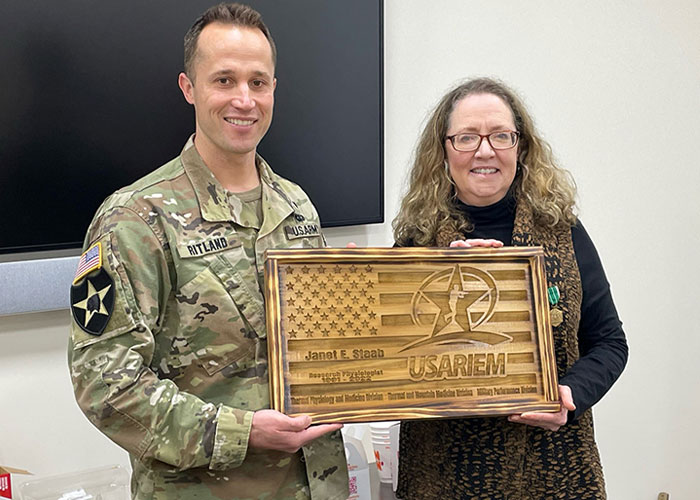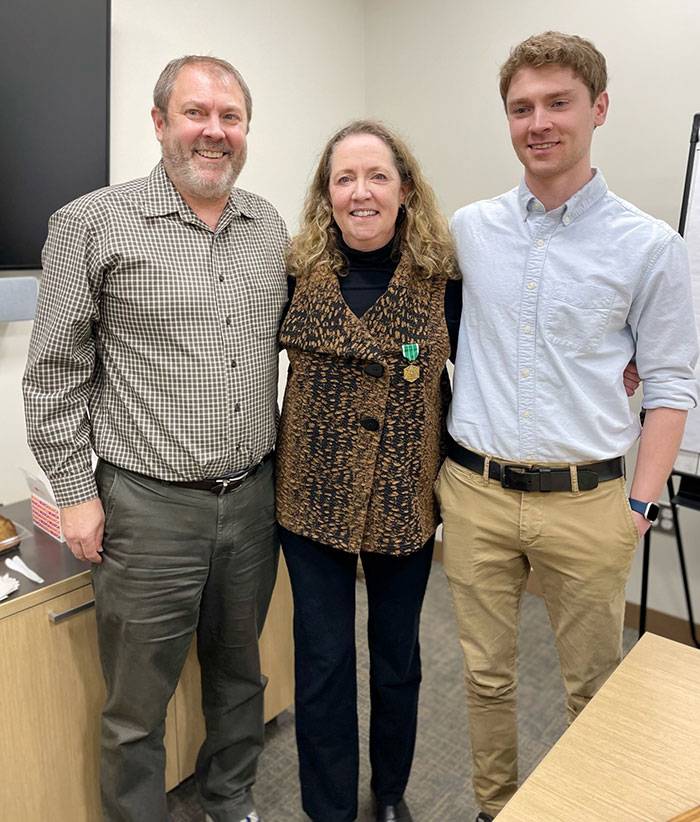USARIEM says farewell to Janet (Laird) Staab after 33 years of service

For Janet Staab, working at the U.S. Army Research Institute of Environmental Medicine was more than a career – it was an extension of her family.
When Staab first walked through the doors of the USARIEM in 1990, 33 years ago, she was a student from Northeastern University. She spent most of her time working in the lab handling many types of body fluids – blood, sweat, urine, and saliva to name a few. Her work led to a critical role in the analysis of biomarkers and a permanent position as a federal civilian in the Thermal Physiology and Medicine Division, now the Thermal and Mountain Medicine Division.
Looking back, Staab reflects on her career.
"My first supervisor was Dr. Michael Sawka. He called me 'bird-dog Staab'," she said.
Sawka coined the endearment, bird-dog Staab, because of her ability to get to the bottom of any problem and solve whatever was thrown at her.
Over her three decades of service, Staab's many accomplishments and research contributions helped to enhance the health and performance of our Warfighters.
As a research physiologist, Janet worked on over 75 research protocols. She mentored and trained 125 students across all the USARIEM divisions. If that's not impressive enough, she co-authored 24-peer-reviewed articles, 1 book chapter, 12 technical reports and over 70 abstracts.
Staab was a key team member in many protocols and studies. She worked on the sunburn protocol with Dr. Kent Pandolf, the circadian rhythm studies with Dr. Margaret Kolka and Dr. Lou Stephenson, the chemical protective clothing studies with Leslie Levine and Bruce Cadarette, the immune response in arctic sojourners with Dr. Rich Gonzales. She was a member of the altitude field studies, teaming up with Dr. Allen Cymerman, Dr. Andy Young, Dr. Steve Muza, Dr. Chuck Fulco, Dr. Paul Rock, and Dr. Beth Beidleman. More recently, she was part of the teams for the Occupational Physical Assessment Test study with Dr. Steve Foulis and Marilyn Sharp, and the ARIEM Reduction of Musculoskeletal Injury study with Dr. Julie Hughes and Dr. Steve Foulis.
Beidleman, mentor and friend to Staab, recognizes more of Staab's accomplishments.

"Some of Janet's most significant accomplishments were helping set up the world's largest Mountain Medicine Database and contributing to the development of the Altitude Readiness Management System, which was fielded to the U.S. Army Forces Command," said Beidleman. "She was also instrumental in data collection efforts for the patent-pending AMS_alert algorithm."
Staab recognized her work on the Acute Mountain Sickness-alert study as the highlight of her career.
"I am thankful to end my career working as an associate investigator alongside my friend and mentor, Dr. Beth Beidleman, on historically the largest USARIEM altitude field study conducted over the past two summers at the Taos Valley Ski Area in New Mexico," Staab said.
Over the years, Staab did her fair share of travelling. Some of her most memorable trips were to support USARIEM research by setting up laboratories in austere environments or presenting data at national and international conferences. She travelled to Pikes Peak, Yuma Proving Grounds, Fort Benning, Fort Carson, Fort Leonard Wood, Fort Bliss, Tripler Army Medical Center, Antarctic Division of Tasmania, Lake Louise, Taos Ski Valley, Jackson Hole and countless temporary duty assignment to Fort Jackson.
Besides her regular everyday tasks and many temporary duty assignments, Staab earned her Master of Science in human physiology from Boston University in 2011 and became a trusted associate investigator across the Institute.
Technical expertise aside, Staab has embraced USARIEM as an extended family. It's where she met her husband, Jefferey Staab, a principal investigator in the Military Performance Division. Their son, Colin, took part in the Gains in Education of Mathematics and Science and Oak Ridge Institute of Science and Education programs. And she was always there for her fellow team members, willing to help with social and team building events across the Institute – birthday celebrations, baby and puppy showers, retirements, care packages for ill team members, and holiday parties.
During Staab's retirement ceremony, Lt. Col. Bradley Ritland, military deputy of the MPD, said, "It's an honor to be able to recognize the contributions of someone that has dedicated her entire career to this institute. Janet can sleep well at night knowing that her contributions have made a lasting impact."
Staab is looking forward to some new adventures during retirement. Bird watching, shell fishing and learning to cook are just a few of those adventures.
"Janet's contributions will have a lasting impact on USARIEM and she will be greatly missed," said Beidleman.
USARIEM is a subordinate command of the U.S. Army Medical Research and Development Command under the Army Futures Command. USARIEM is internationally recognized as the DOD's premier laboratory for Warfighter health and performance research and focuses on environmental medicine, physiology, physical and cognitive performance, and nutrition research. Located at the Natick Soldier Systems Center in Natick, Massachusetts, USARIEM's mission is to optimize Warfighter health and performance through medical research.













